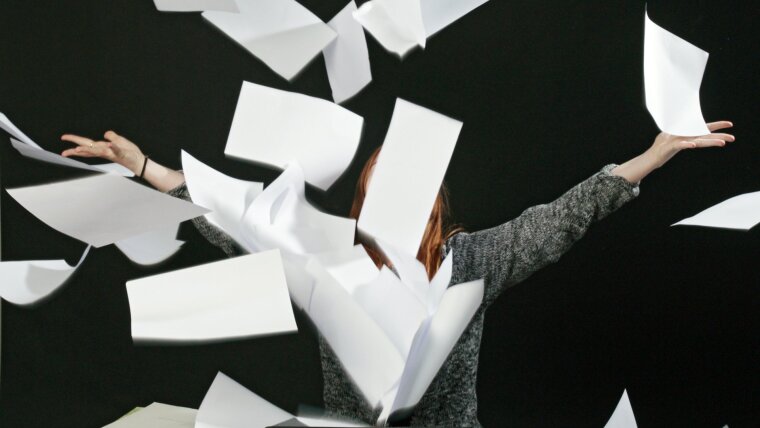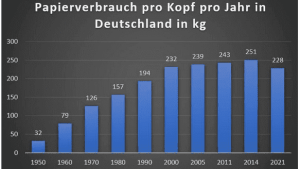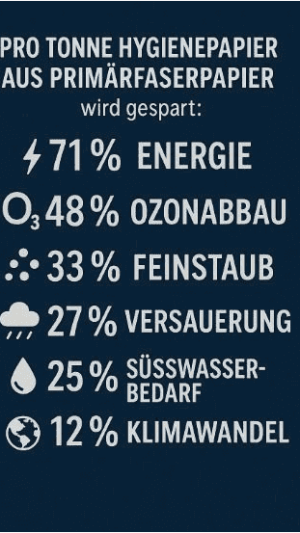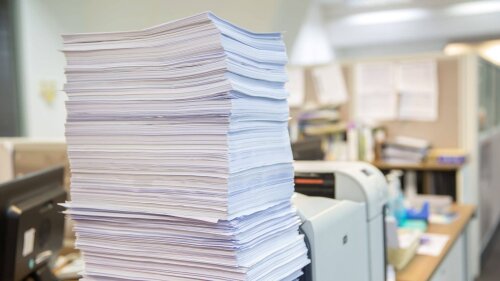
Initial situation, opportunities, challenges
Papierverbrauch pro Kopf
Image: Frederik SelleToday, digitalisation is responsible for 4-8% of greenhouse gas emissions. On the other hand, office employees use an average of 40-50 sheets of paper per day. That is the equivalent of a tree every 2.5 years (40 thousand sheets equals one tree). Using 1 kg of recycled paper instead of 1 kg of virgin fibre paper would save as much energy as it takes to make 210 cups of coffee (3 kWh).
Recycled paper protects forests, the climate and biodiversity. The condition of the forests is changing, as many forests are ill. There are also many monocultures. Species-rich forests can store twice as muchCO2 and are more resilient to climate change than monocultures. They reduce the risk of natural disasters, regulate water cycles, have a positive impact on the microclimate and increase biodiversity.
Blue Angel eco-label
Übersicht Einsparungen Recyclingpapier statt Primärfaserpapier
Image: Frederik SelleThe Blue Angel eco-label requires the highest ecological standards in Germany and is the most environmentally friendly choice for paper. The papers that have been awarded this label are made from 100% recycled paper from the lower and medium grades of waste paper.
The products are manufactured efficiently in terms of energy and water. The Blue Angel also prohibits the use of harmful chemicals in the processing of waste paper. The suitability for use and age resistance have been defined by DIN.
Attention is paid to noise reduction and electromagnetic radiation is avoided. In general, international health and safety standards are complied with.
What can you do to save paper at the university?
Here you will find some ideas, suggestions and inspiration for your everyday university life:
- when printing orders via the Print Centre or online print shops: make sure to use recycled paper
- discuss with the Print Centre and University Communications how the proportion of recycled paper and materials can be increased at events and marketing activities
- clarify with the chancellor/faculties/institutes: can the use of new paper be avoided?
- Ask the University Computer Centre whether double-sided printing can be set as the default setting?
- enquire whether recycled toilet paper can be used
- Other important contacts are secretaries and team assistants, who are often responsible for purchasing
- Unsubscribe from unwanted catalogues, brochures and magazines
- you can make stacking boxes from waste paper in which you can collect papers whose reverse side can still be printed on
- the Green Printing software removes blank pages and unnecessary information from the file to be printed
- Documents can be digitised and sent via scan-to-email
- Letters can also be sent electronically, e.g. via www.epost.deExternal link
Further information
The information and suggestions for everyday university life on this page are based on a workshop on 8 May 2025 in cooperation with Susanne Spies from the Federal Environment Agency as part of the 1st Week of Sustainability, which was organised by the University's Green Office together with partners.
Further interesting materials:
Recycled paper protects forests, climate and biodiversityExternal link
The future of paper in a digital worldExternal link
Paper: Why the Blue Angel is more demanding than FSCExternal link


